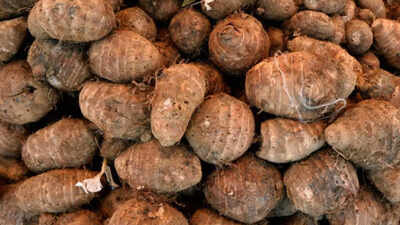ARTICLE AD BOX

The monsoon season offers a welcome change, with its cool, rainy breeze and verdant surroundings. Plants are nourished by rainwater, and the aroma of moist soil produces a revitalising environment.
Growing vegetables in your backyard or garden during the monsoon can be really fun. But do all vegetables give you that same joy? Some vegetables grow beautifully in the monsoon season, while others may struggle with too much water or humidity. Choosing the right vegetable to grow can make all the difference between a bountiful harvest and a frustrating gardening experience.Arbi, also known as Colocasia, is one of the easiest vegetables to grow during the monsoon.
There’s something special about enjoying a warm plate of spicy arbi on a rainy day, especially when the arbi comes straight from your own garden. It is a low-maintenance, easy-to-grow root vegetable that thrives during the monsoon season.
10 steps to grow arbi in your garden
1. Selecting the Proper Location: Select a partly shady spot which receives light during the morning sun and afternoon shade. Arbi prefers a partly sunny location, but not too sunny or hot.
A too hot environment will dry out the soil too quickly. 2. Choosing Healthy arbi Corms: Choose firm, mold-free corms. It is even better to choose some that have small shoots giving you a little edge. Choosing good corms is the best start to a strong plant. 3. Soaking: Soak in water for about 24 hours. This helps to soften the outer layer a bit and will provide a slightly faster growth and make it easier for the shoot to push through and tell the corm to come up.
The next day, plant the corms. 4. Preparing Nutrient Rich Soil: Mix garden soil with compost or cow dung, so arbi has some nutrients. If using heavy soil, add moisture-retaining sand or cocopeat. Use a shovel, fork or your hands to break the clumps up and remove any stones. Unclump the soil to it becomes soft and fertile. This way the roots will be developed and corms will be bigger. 5. Planting the Corms: Make holes in the soil about 4-6 inches deep, and place the arbi corms in them, pointed bud side upwards. Cover with soil. Space the corms at least 1 foot apart to avoid overcrowding and lower the chance of disease6. Water Regularly: Keep the soil moist, especially during early stages.
Water when the topsoil feels dry, but rely on rain if it's regular.7. Weed & Mulch: Remove weeds by hand and add mulch like dry leaves or straw to retain moisture and suppress weeds.8. Fertilize: Feed the plants with natural fertilizers like compost or cow dung slurry every 2-3 weeks for healthy growth.9. Pest Control: Check for bugs like aphids weekly and spray neem oil or soapy water if needed. Remove yellow or spotty leaves to prevent fungal spread.10. Harvest: After 4-5 months, when leaves turn yellow and droop, loosen the soil gently and lift out the corms without damaging them.



.png)
.png)
.png)
















 4 hours ago
2
4 hours ago
2









 English (US) ·
English (US) ·